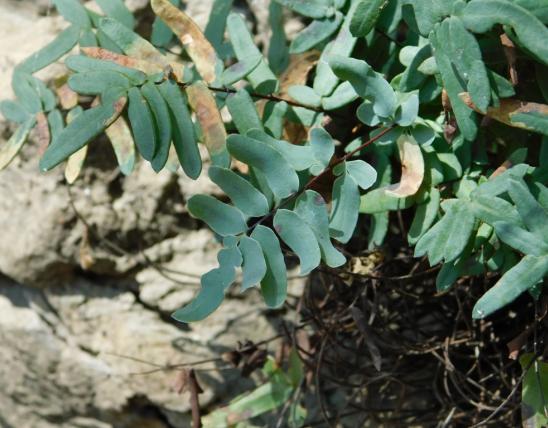
Hairy lip fern is a hairy, perennial fern that usually grows on rock crevices and ledges. The leaves usually arise along the creeping rhizome (as opposed to growing in a tuft). Leaf stalks are dark brown, hairy with jointed hairs, but with no scales. Leaf blades are 2 times pinnately compound. Subleaflets (pinnules) usually lobed, but not beadlike. Fertile subleaflets are oblong or ovate; the undersides are hairy but not matted or woolly. Spore clusters form on the bottom surface of the leaves, along the outer edge; the leaf edge curls under and partially covers the spore clusters. Spores are produced June–September.
Similar species: Three other lip ferns in genus Myriopteris occur in Missouri.
- Slender lip fern (M. gracilis; formerly Cheilanthes feei) is scattered statewide except for the northeastern quarter and the Bootheel lowlands. Its fertile subleaflets are beadlike, with densely hairy and matted, woolly hairs on the undersides; the leaves grow in a tuft (not along a creeping rhizome). Leaf stems dark brown to black.
- Smooth (or Alabama) lip fern (M. alabamensis) is uncommon in southwestern Missouri and grows in crevices of dry limestone and dolomite bluffs and boulders. Its leaflet lobes are hairless or only sparsely hairy beneath. The leaves grows in a tuft. Leaf stems are black.
- Woolly lip fern (M. tomentosa) is uncommon in southwestern Missouri and grows in crevices of dry limestone and dolomite bluffs and boulders. Its leaf stems are coarse, dark brown, densely hairy, with the hairs mixed with linear scales. The leaves are hairy above, densely woolly below. Leaves grow in a tuft.
Habitat and Conservation
Status
Life Cycle
Ferns have a two-part life cycle. The plants we usually see are called sporophytes, which produce spores that germinate and become the other part of the life cycle, the gametophytes. Gametophytes in this family of ferns are small, green, flat, kidney- or heart-shaped plants that few people notice. The gametophytes produce eggs and sperm, which unite to become a new sporophyte plant.
Lip ferns, however, are famous for reproducing via apogamy. Apogamy is when a new sporophyte plant forms without fertilization — so it has the same number of genetic copies as the gametophyte. Except for hairy lip fern, our other 3 lip ferns are apogamous species — they essentially bypass the sexual reproduction part of the typical fern life cycle.
Human Connections
People sometimes grow hairy lip fern and its relatives in rock gardens and other natural landscaping situations where its drought tolerance is a plus. If you are thinking about adding native ferns to your garden, make sure you get them from responsible dealers, or learn how to propagate them yourself from spores. Transplanting this slow-growing fern is rarely successful. Never dig them from the wild.
Molecular (DNA) studies have revolutionized — and clarified — how biologists view the relationships among plants, animals, and other organisms. Just as it helps scientists determine how closely related a group of plants are, the same DNA tools help people discover their ancestry, prove paternity, and solve crimes.
The name “lip fern” comes from the curled-under, liplike leaflet edges. The old genus name, Cheilanthes, means “lip/margin” and “flower,” also referring to the spore clusters’ liplike protectors. The current genus name, Myriopteris, means “very many” and “fern,” apparently referring to myriad of tiny, rounded, “beadlike” subleaflet lobes on many species in this group.
Ecosystem Connections
Hairy lip fern, like several other kinds of ferns, supplements its ability to get nutrients and moisture with symbiotic fungi (mycorrhizae), which are connected to the roots.
Most ferns are associated with moist, rich, lowland soils in shady locations. One reason for this is that the sperm from the gametophyte generation must swim to reach eggs. Lip ferns, however, are zerophytic (dry-loving). Hairs on the surface of the waxy-coated leaves help prevent them from losing moisture, and apogamy (a form of asexual reproduction) lets them bypass the need for sperm.
This species is listed as threatened or endangered in at least four states, all at the edges of its overall range.



































